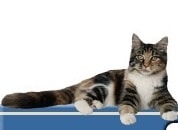|
         |
|
|
 Fun Facts Fun Facts
|
Contents
|
|
Body Language
DogFancy April 2013
Parents post them on Facebook and Twitter or send them around in email attachments: adorable photos and videos of gleeful toddlers kissing dogs on the face or squeezing them tight in bear hugs. The kids are loving the close contact. The dogs? Not so much.
"I think one of the best things we can do is teach kids about body language," trainer and author Colleen Pelar says. "When we start to teach kids how to read a dog, then they're going to be much better at interacting with dogs."
This is a safety issue as well. About 4.5 million Americans are bitten by dogs each year, and the rate of bite-related injuries is highest for those ages 5 to 9, according to the Centers for Disease Control and Prevention.
Here's Pelar's head-to-tail guide of what to look for in your dog's body language:
- Mouth and Jaw
Relaxed and open signals a calm, happy dog. Tight lips? They indicate that a dog is annoyed or uncomfortable.
- Eyes
A relaxed dog has an open, droopy eye. A frightened dog often displays what's called "whale eye," with the whites of the eyes showing.
- Ears
Depending on your dog's ear type and shape, you can pick up on cues based on their position. When comfortable, your dog will hold her ears naturally. When alert, she'll generally keep them forward. Ears that are held back slightly indicate friendliness. However, ears held back and flat against your dog's head suggest she's likely frightened or feeling submissive.
- Body Posture
Comfortable dogs are relaxed, leaning in toward people. Unhappy dogs tend to lean away or lean back in an attempt to get out of a situation. Dogs that are tense show it in tightened muscles and rigid bodies.
- Hair
If his hair is standing up on his back, he may be scared, uncomfortable, upset, or otherwise excited about something.
- Tail
Not every wag is a happy one. Dogs that are overstimulated tend to carry their tails up and have a rigid wag. Fearful dogs carry the tail low or beneath them. Happy dogs hold the tail at medium height and have a nice, loose wag.
|
|
| Back to Top |
|
|
5 Most Common Easter Toxins
ASPCA Animal Poison Control Center ASPCA Animal Poison Control Center, Source
Watch out for these common Easter toxins!
- Chocolate
Problem:
Easter is typically the top day for chocolate intoxication calls to the ASPCA Animal Poison Control Center, topping Christmas, Valentine's Day and even Halloween. Why? Pets often find candy hidden around the house and yard or Easter baskets left unattended.
Solution:
Make sure all candy is out of reach of pets at all times.
- Lilies
Problem:
True lilies and daylilies are a concern for acute kidney failure in cats. All homes with cats should be very careful with Easter lilies.
Solution:
The APCC suggests lilies not enter the house with cats. However, if they must be there, make sure cats don't have access to any part of the plant, including pollen, petals that fall or even the water the flowers were stored in - all can cause life-threatening problems.
- Easter Grass
Problem:
The plastic grass that is found in Easter baskets is appealing to pets and can cause a life-threatening gastrointestinal obstruction which can require surgery to resolve.
Solution:
Don't leave Easter grass lying outside on the lawn after festivities are over. Keep grass out of the reach of all pets while in the house and dispose of used grass in pet-proof container.
- Table Food
Problem:
Onions, garlic, macadamia nuts, grapes and raisins are common toxic foods pets ingest, and many foods that aren't toxic may cause stomach upset or lead to pancreatitis.
Solution:
Don't leave scraps on the table or counter unattended, and dispose of uneaten food in pet-proof containers.
- Herbicides
Problem:
Easter often brings springtime yard work, leading to animals ingesting herbicides. Pets love the salty taste and may ingest mist in the air while the products are being sprayed.
Solution:
Keep all herbicides where pets can't chew or puncture bottles and make sure lawns are dry before letting pets outside. While many herbicides are not highly toxic, any exposure warrants a call to the vet.
Watch this video for poison prevention tips from the APCC's own toxicologist, Dr. Tina Wismer. |
|
| Back to Top |
|
|
Simple, Healthy Snacks for Your Canine Companion
Modern Dog Modern Dog
You don't need to run to the pet store to find scrumptious treats for your dog-here are twelve single-ingredient healthy dog treats found in our cupboard and crisper!
- Cabbage: a member of the cruciferous vegetable family, cabbage is cancer-fighting. Try steaming a little cabbage and add to your dog's dinner-add just a bit though, so as to not upset your dog's stomach or have him clear the room with post-dinner flatulence. Too much cabbage equals gas.
- Frozen sardines: these tiny fish are rich in omegas and tasty to boot. Due to their small size, sardines can be fed whole. Keep a bag of them in the freezer for a chilly, crunchy little treat.
- Brown rice: bland yet filling, brown rice is especially good for feeding to dogs with upset stomachs.
- Red pepper: packed with vitamins, slices of raw red peppers are a sweet treat lots of dogs adore. Feed fresh or slice and freeze for a cool treat.
- Pumpkin: this bright orange veggie is rich in carotenoids, beta-carotene, alpha-carotene, fiber, zinc, iron, vitamin A, and potassium. Either cook it in the oven or buy it canned (unsweetened, of course). Be sure not to accidentally buy pumpkin pie filling! Best of all, pumpkin can help your dog lose weight; it's low-fat, but filling thanks to its high fiber content, so you can decrease your dog's dinner portion but top it with a bit of canned or cooked, pureed pumpkin to help him feel full. Because of its high fiber and water content it can also bulk up stool and help with diarrhea and constipation. Start by giving a tablespoon or two of pureed pumpkin a day. Pumpkin is also a great ingredient to add to many homemade dog treats!
- Apples: lots of dogs love sweet, crispy apple slices-which is great as apples contain calcium, vitamin K, vitamin C, and pectin (soluble fiber). Remove the core and seeds though; apple seeds and stems contain cyanogenic glycosides, so you'll want to avoid letting your dog consume apple cores and stems.
- Quinoa: this ancient grain has received a lot of buzz as of late, and with good reason. It's great for dogs with grain sensitivities and, like brown rice, is a great stomach settler.
- Carrots: pack a raw baby carrot or two for a great on-the-go dog treat. Or cook them and mash them into your dog's dinner for a sweet and healthy addition. Or freeze some baby carrots for a chilly sweet treat that will naturally clean your dog's teeth.
- Cauliflower: many dogs love cancer-fighting cruciferous vegetables like broccoli and cauliflower. If your dog needs some convincing though, chop it up so it resembles feta cheese and sprinkle some on your dog's dinner. Keep in mind that too much broccoli and cauliflower, particularly raw, can cause gas so keep those portions small!
- Cheese: most dogs adore a tidbit of cheese, making it a great high-value reward for training. Just remember that cheese can be high in calories and keep in mind that softer unripened cheeses are more likely to cause stomach upset.
- Dehydrated apricots: dried apricots make for a sweet healthy treat that travels well, perfect for indulging a dog with a sweet tooth. Do mind the portion size; dehydrated apricots contain all of the nutrients of the fresh ones, but they have no water, so only feed little bits of dried apricot to prevent tummy upset.
|
|
| Back to Top |
|
|
Great Grooming Tips for Your Feline Friend
CatFancy October 2013
While cats are generally great self-groomers, they also need a little help on a regular basis to keep their fur fabulous and their toenails trimmed. Here are some suggestions for making grooming time pleasant and productive for you and your kitty:
- Get a routine going: you can never start too early! Young kittens do not shed, but they still enjoy being brushed with a very soft brush, and will benefit from the interaction. It's also a good idea to play with them by touching their paws, splaying their toes and gently massaging their paw pads. This will stand you in good stead when they are older and need regular manicures.
- Find the right spot: if you'll be grooming your cat on a flat surface, place a towel on the surface. It will give your cat something to grip instead of sliding around on a slick, smooth surface. Also keep in mind that the best place to groom will be the place your cat selects. You'll have more success in grooming if your cat is in charge of the location. Similarly, it's important to let your cat dictate what happens in a grooming session. Allow her to leave when she's had enough. If necessary, break grooming-time up into short periods over several days instead of trying to do a complete grooming in one sitting.
- Brush with care: how often you brush your cat will depend a lot on whether she has long or short hair. Ideally, a longhaired cat should be brushed daily to ensure that the hair doesn't mat, which it can do quickly.
- Use the right tools: the secret to successful grooming is to ensure that you have the right grooming tools. It's worth investing in good quality products. For longhaired cats, professional groomers recommend a 7-inch stainless steel comb, since brushes tend to split and break long hair. Place your hand just in front of the area to be worked on, and use short, quick, upward strokes so that you are lifting, and not pulling. To remove loose hair and give your cat a nice massage at the same time, try a rubber comb with long teeth (also known as a curry brush). This works well on all feline fur. Your basic grooming toolbox should include the following:
- An inexpensive slicker-brush for removing tangles, dead hair and debris while distributing healthy oils.
- A selection of brushes with nylon bristles to give the coat a smooth, silky look.
- A fine, short-toothed comb to gently remove any matted hair and for removing hair from the slicker brush.
- A de-shedding tool to help keep the undercoat thinned without cutting the hair.
- A fine flea comb for removing both fleas and eggs and for gently grooming facial areas.
- A hair-grabbing mitt to remove loose hair and give a nice massage at the same time.
- A rubber comb with large teeth (curry brush) that magnetically lifts loose fur and massages the natural oils throughout the coat.
- Pet-specific nail cutters for cutting efficiently and not tearing the nail.
- Master mats: Cats have very delicate skin and with a bad mat, it's easy to accidentally slice into the skin and cause serious bleeding if you try to use scissors to eliminate the problem. It's better to seek professional help with matted fur. Once the situation has been remedied, regular grooming at home can prevent matting from happening again. A de-shedding tool, such as the Furminator, is especially good at removing dead hair in the undercoat, which is the source of most mats. Use one specifically designed for cats, because the ones for dogs can thin a cat's coat too much.
- Provide a mani-pedi: invest in a pair of good, stainless steel pet nail trimmers. Human nail clippers can split your cat's nails and cause more issues. Be sure to cut only the end of the nail and not the quick (the pink part) which is the blood supply. Instead, trim a little at a time and more often.
- Know when to bathe or not to bathe: most cats are not keen on being bathed. In fact, many get really stressed when put in the tub, and it can cause their blood pressure to spike. But there are alternatives, such as waterless shampoos and specially formulated feline wipes, which will remove any dust and dander from the fur effectively and without fuss. There are occasions, however, when a cat needs a bath. In those situations, follow these steps to help keep your cat's stress level from soaring:
- Start with an empty sink or tub. Do not attempt to put your cat into a container filled with water. This could traumatize your cat. Instead, place a rubber mat in a clean, empty sink or tub, and stand your cat onto the mat to keep her from slipping
- Test the water. The water should be comfortably lukewarm on the inside of your forearm.
- Bring the water to the cat. Use a spray hose or a non-breakable cup or pitcher to pour the water slowly and gently over your cat, speaking softly to her to keep her calm.
- Use only a cat-specific shampoo. All species have a specific pH balance, and using a shampoo not balanced for cats can cause skin irritation. Carefully follow the instructions on the packaging (which you will want to read beforehand). Avoid getting shampoo in your cat's face, eyes, or ears.
- Rinse thoroughly. Shampoo residue can contribute to skin allergies. Your cat will also ingest it when she grooms herself, so rinse until all residue disappears and you see clear water going down the drain. Again, carefully avoid the face, eyes and ears.
- Towel dry. Have a clean bath towel ready and gently stroke your cat's fur to soak up as much water as you can. At this point, some cats will run off to find a hiding place where they will groom themselves dry. Keep the house warm and free from drafts until your cat is completely dry.
- Reward. Talk to your cat gently and lavish her with praise during this entire bathing process. Whether your cat runs to hide after the bathing experience, or takes the whole thing in her stride, give her some extra love and a treat.
|
|
| Back to Top |
|
|
Canine Training Tips
DogFancy October 2013
Just like people, dogs have different learning styles and motivations. Knowing what makes your puppy pay attention to your Sit command will help you be successful in training. Savvy dog trainers rely on three basic kinds of motivation: food, praise, and play.
- If your puppy responds to praise, the key is to keep it short. Give it only when your dog does something good. Don't constantly say "Good girl!" for reassurance.
- If play is your pup's thing, keep it short. Any play reward lasting longer than 10 to 20 seconds will make your dog forget what she was rewarded for.
- If your pup loves food, use small, convenient bits that do not require chewing. Anything larger (or chewier) than pea-size may take your puppy's mind off the important task at hand.
|
|
| Back to Top |
|
|















